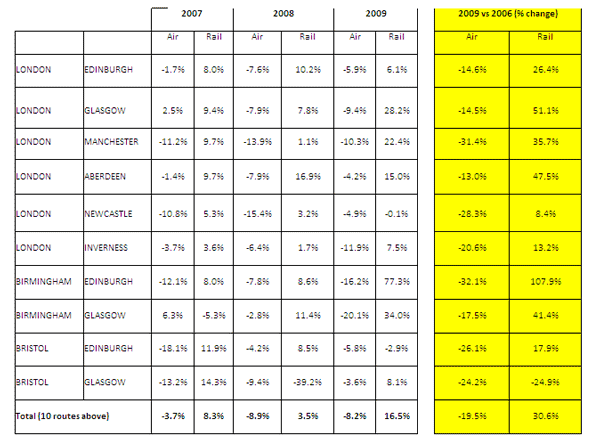Surge in intercity rail passengers points to fundamental shift in way britons travel
Posted: 16 September 2010 | | No comments yet
A fundamental shift in the way that people travel around the country is taking place, as new figures show…
A fundamental shift in the way that people travel around the country is taking place, as new figures show...
A fundamental shift in the way that people travel around the country is taking place, as new figures show that people are increasingly turning their backs on domestic flying and choosing instead to travel between Britain’s major cities by rail.
Figures published today by the Association of Train Operating Companies (ATOC) show that in recent years, rail’s market share on routes that have traditionally been dominated by domestic air travel, has risen significantly.
Over the last 18 months, rail’s market share has seen a particularly sharp surge, as tough economic times have led to increasing numbers of people taking advantage of value for money rail tickets:
- For Birmingham to Edinburgh, market share has risen from 14% in 2008 to 31% in June 2010
- For London to Manchester, market share has risen from 69% in 2008 to 85% in June 2010
- For Birmingham to Glasgow, market share has risen from 15% in 2008 to 27% in June 2010
- For London to Glasgow, market share has risen from 12% in 2008 to 21% in June 2010
These changes are due to the increase in the number of rail journeys made on key intercity routes, and a decline in numbers flying between these cities. Between 2006 and 2009, total journeys by rail on the 10 most popular domestic air routes rose by 31%, while over the same period, numbers using domestic air travel fell by 20%. In 2009 alone, demand for rail services on the top 10 routes jumped by 17%, with journeys up by almost one million.
Journey numbers have seen another boost in the first six months of this year as the volcanic ash cloud meant even more people took the train. On many of the 10 routes, rail market share figures have remained higher than before the ash cloud hit in April, suggesting that large numbers of people who switched to rail during the ash cloud have continued to choose the train.
Train companies attribute the trend to significant investment that has been made to cut journey times and provide more frequent train services; increasing availability of good value fares on intercity trains; and an increasing awareness of rail’s green credentials. In addition, rail passengers do not have to put up with lengthy check-in and security measures at airports.
Edward Welsh, Director of Corporate Affairs at ATOC, said: “It is clear that a fundamental shift in the way that people get around the country is taking place. Ever greater numbers of people choosing rail travel to get between our big cities is good news for the environment, and shows the importance of the railways in supporting the economy.
“The volcanic ash cloud led to a spike in rail journey numbers as train operators laid on extra services to get people around the country. But this merely accelerated a trend seen in recent years, most notably last year, when tough financial times led people to opt for the train.
“Considerable improvements have been made on the railways in the last few years to cut journey times, run more frequent services and to make services even better for passengers. Rail passenger satisfaction has never been higher, punctuality has never been better, the number of complaints has never been lower and investment in rail has never been more sustained – which all adds up to great value for money.
“If these trends continue, we can expect domestic air to become the choice of the minority, with flying between some cities disappearing altogether. “


Table 1: Rail market share


Table 2: Passenger journey numbers



